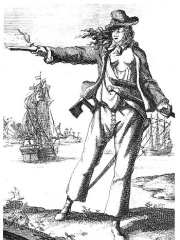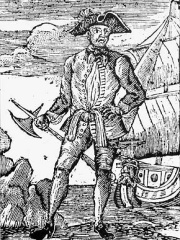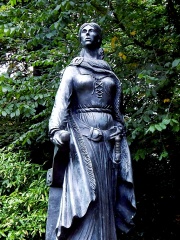


The Most Famous
PIRATES from Ireland
Top 3
The following people are considered by Pantheon to be the most legendary Irish Pirates of all time. This list of famous Irish Pirates is sorted by HPI (Historical Popularity Index), a metric that aggregates information on a biography’s online popularity.

1. Anne Bonny (1702 - 1782)
With an HPI of 68.52, Anne Bonny is the most famous Irish Pirate. Her biography has been translated into 48 different languages on wikipedia.
Anne Bonny (late 17th century – disappeared after 28 November 1720), sometimes Ann Fulford, was an Irish pirate operating in the Caribbean, and one of the few female pirates in recorded history. What little that is known of her life comes largely from Captain Charles Johnson's 1724 book A General History of the Pyrates. Bonny was born in Ireland at an unknown date, and later moved to London and then to the Province of Carolina. Around 1718 she married sailor James Bonny, assumed his last name, and moved with him to Nassau in the Bahamas, a sanctuary for pirates. It was there that she met Calico Jack Rackham and became his pirate partner and lover. She was captured alongside Rackham and Mary Read in October 1720. All three were sentenced to death, but Bonny and Read had their executions stayed because both of them were pregnant. Read died of a fever in jail in April 1721 (likely due to complications from the pregnancy), but Bonny's fate is unknown.

2. Edward England (1685 - 1720)
With an HPI of 60.20, Edward England is the 2nd most famous Irish Pirate. His biography has been translated into 20 different languages.
Edward England (c. 1685–1721) was an Irish pirate. The ships he sailed on included the Pearl (which he renamed The Royal James) and later the Fancy, for which England exchanged the Pearl in 1720. His flag was the classic Jolly Roger — almost exactly as the one "Black Sam" Bellamy used — with a human skull above two crossed bones on a black background. Like Bellamy, England was known for his kindness and compassion as a leader, unlike many other pirates of the time. England was born Edward Seegar in Ireland around 1685. He took part in Henry Jennings' expedition for the sunken 1715 Treasure Fleet off the coast of Florida, and then began sailing with Charles Vane in 1718. Upon Vane and other prominent pirates accepting the King's Pardon, England and some of his men sailed for Africa. Along his way he spawned the career of Bartholomew Roberts, among others. In 1720, near the African island of Comoros, England and his men got into a violent conflict with James Macrae. After 10 days of hiding on an island, England and Macrae agreed to a peace deal, upsetting England's crew; he was subsequently voted out as captain and marooned on the island of Mauritius. After four months, England and the loyal crewman that had been stranded with him managed to build a boat and sail to a pirate safe haven in Madagascar. He died sometime in the winter of 1720–21, possibly from tropical disease.

3. Grace O'Malley (1530 - 1603)
With an HPI of 52.88, Grace O'Malley is the 3rd most famous Irish Pirate. Her biography has been translated into 28 different languages.
Gráinne O'Malley (Irish: Gráinne Ní Mháille, pronounced [ˈgˠɾˠaːn̠ʲə n̠ʲiː ˈwaːl̠ʲə]; c. 1530 – c. 1603), also known as Grace O'Malley, was the head of the Ó Máille dynasty in the west of Ireland, and the daughter of Eóghan Dubhdara Ó Máille. Upon her father's death, she took over active leadership of the lordship by land and sea, despite having a brother, Dónal an Phíopa Ó Máille. Marriage to Dónal an Chogaidh (Donal "of the war") Ó Flaithbheartaigh brought her greater wealth and influence, reportedly owning as much as 1,000 head of cattle and horses. In 1593, when her sons Tibbot Bourke and Murchadh Ó Flaithbheartaigh (Murrough O'Flaherty) and her half-brother Dónal an Phíopa ("Donal of the Pipes") were taken captive by the English governor of Connacht, Sir Richard Bingham, O'Malley sailed to England to petition for their release. She formally presented her request to Queen Elizabeth I at her court in Greenwich Palace. O'Malley is not mentioned in the Irish annals, so documentary evidence for her life comes mostly from English sources, especially the eighteen "Articles of Interrogatory", questions put to her in writing on behalf of Elizabeth I. She is mentioned in the English State Papers and in other documents of the kind, as well.In Irish folklore she is commonly known as Gráinne Mhaol (anglicised as Granuaile) and is a well-known historical figure in sixteenth-century Irish history. Her name was also rendered in contemporaneous English documents in various ways, including Gráinne O'Maly, Graney O'Mally, Granny ni Maille, Grany O'Mally, Grayn Ny Mayle, Grane ne Male, Grainy O'Maly, and Granee O'Maillie, rarely as Grace O'Malley. In popular culture, she is often referred to as "The Pirate Queen".
People
Pantheon has 3 people classified as Irish pirates born between 1530 and 1702. Of these 3, none of them are still alive today. The most famous deceased Irish pirates include Anne Bonny, Edward England, and Grace O'Malley.
Deceased Irish Pirates
Go to all RankingsAnne Bonny
1702 - 1782
HPI: 68.52
Edward England
1685 - 1720
HPI: 60.20
Grace O'Malley
1530 - 1603
HPI: 52.88

